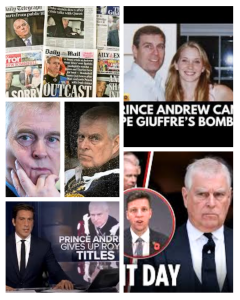Prince Andrew stared at the decree—HRH erased, medals revoked, a lifetime of privilege dust in one royal blink. Twenty-four hours later, Virginia Giuffre’s father shattered the silence on ABC, voice trembling, unveiling a locked box: Polaroids, a child’s diary, a prince’s scrawled note. “They buried her pain,” he choked. “We unearth it.” Tears, fury, unbreakable truth flooded the screen as siblings demanded justice.
The box held one final photo—face blurred, crown visible.

Prince Andrew stared at the royal decree in stunned silence. His Royal Highness—gone. Medals—revoked. Military honors—stripped. In one swift, surgical command from King Charles, decades of privilege turned to dust. Courtiers described him as pale, motionless, “a man watching his own history vanish.” The email had arrived at dawn; by breakfast, the Duke of York was no more—just Andrew Windsor, a royal in name only.
For the monarchy, it was meant to be closure—a clean excision of scandal before it spread any further. But the past, long buried beneath gold and ceremony, was already clawing its way to the surface.
Twenty-four hours later, ABC News aired what would become the most haunting broadcast in the royal saga. Seated under harsh studio lights, Virginia Giuffre’s father clutched a small metal box, its edges rusted, its lock newly broken. His hands shook as he set it before the camera. “They buried her pain,” he said, voice cracking. “We unearth it.”
He opened the box slowly. Inside lay a collage of ghosts—faded Polaroids of a teenage girl smiling through uncertainty, a diary bound in cracked leather, and a single note scrawled in hurried ink: “Stay strong. I believe you.” The signature, the father claimed, matched a royal hand. ABC blurred it, citing “verification protocols,” but the internet had already erupted with speculation.
As the camera zoomed in, Virginia’s siblings joined him on set. One read from the diary—entries filled with longing, confusion, and fear. “He said I’d be safe,” one line read. Another simply said: “He wore medals.” A chill swept through the studio. Viewers across continents held their breath.
The family’s grief turned to fury. “For years, they told us to stay quiet,” her brother said, tears glinting. “They said no one would believe a girl against a prince. But she believed in justice. And now—so do we.”
The segment ignited a media firestorm. Within hours, hashtags demanding a full royal inquiry trended worldwide. Buckingham Palace declined comment, issuing only a one-line statement about the King’s “commitment to integrity and compassion.” Yet insiders whispered of panic behind closed doors. One aide reportedly described the atmosphere as “controlled collapse.”
But it was the final moment of the broadcast that turned whispers into dread. As Giuffre’s father prepared to close the box, the camera caught a final photograph—face blurred by editors, but unmistakable in detail: a jeweled crown glinting above a shadowed figure.
The studio fell silent. The screen faded to black.
No one knows who was in that final image, or why it remained locked away for so long. ABC has not confirmed whether it will release the unredacted photo. But for millions watching, the message was already clear: this was no longer a scandal—it was an awakening.
King Charles may have stripped his brother to save the monarchy. But with one box opened and one blurred crown revealed, the past is no longer buried.
Because when truth breaks its lock, even kings must tremble.
Leave a Reply